Case History Of A Wikipedia Page: Nabokov's 'Lolita'
by Emily Morris

Wikipedia has an article on almost every subject — including, it turns out, one on how to write “the perfect Wikipedia article.” The guidelines run through a list of the attributes such an article would have — e.g., “[i]s precise and explicit,” “[i]s well-documented,” “[i]s engaging” — before ending on a cautionary note: The perfect Wikipedia article is, by virtue of the collaborative editing process that creates it, “not attainable”: “Editing may bring an article closer to perfection, but ultimately, perfection means different things to different editors.” And as editors pursue perfection, they also must keep in mind another essential quality of a good Wikipedia entry: neutrality. That is, no matter how controversial a topic, an article must present “competing views on controversies logically and fairly, and pointing out all sides without favoring particular viewpoints.”
As a member of the Arbitration Committee, Ira Matetsky settles the kinds of editorial disputes that controversial articles tend to incite. In a series of thoughtful guest posts on The Volokh Conspiracy, Matetsky explained some of the mechanics behind the editorial process. He noted that, generally, while “articles on non-contentious topics are usually accurate; articles on highly contentious articles are usually accurate on basic facts, but can be subject to bias and dispute with respect to the matters in controversy.” As a way of investigating Matetsky’s point (and with Wikipedia editathons making news (sub. req.)), we thought we’d chart the history of a single Wiki entry by using that nifty “View History” button. And what’s a page that’s constantly being edited, has as its subject a work of art with an, ahem, unconventional sense of morality, and is therefore constantly subjected to the editing whims of people with strong opinions, moral or otherwise? She goes by many names, but on my greasy MacBook Pro screen, she is always “Lolita.”
Since 2001, the Wikipedia entry on Vladimir Nabokov’s Lolita has been edited 2,303 times. It’s a popular entry, too: of approximately 750,000 Wiki articles out there, it ranks at 2,075 in traffic.
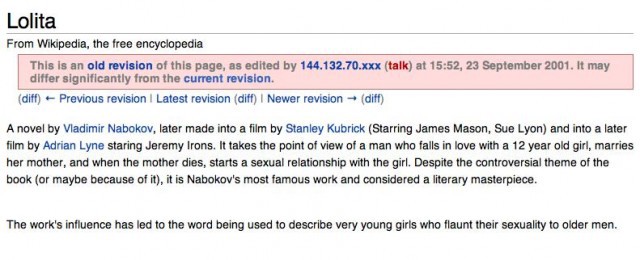
In the past ten years, the entry has grown from the four-sentence description, shown above, to the detailed, 6,000-plus-word monolith of today. The two Lolita films now have their own pages, while the entry on the novel has expanded to include sections on such subjects as Lolita’s Russian translation and its literary allusions. An edit is made, on average, about every other day.
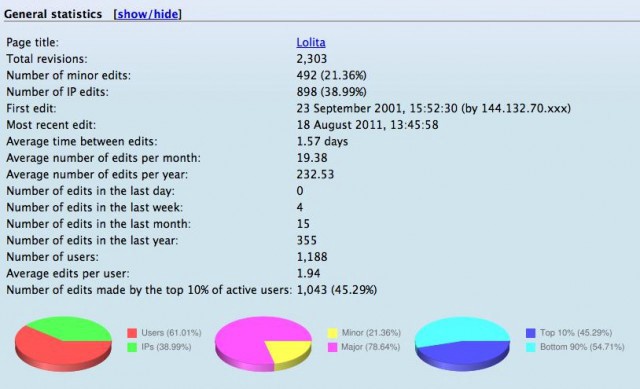
A sift through those 2,303 edits turns up three reasons that users alter the Lolita Wikipedia page: technicalities, new information and debate.
TECHNICALITIES AND MINUTIAE
Par for the course for any article. These details matter to nitpickers, without whom Wikipedia wouldn’t be nearly as reliable.



NEW INFORMATION
Updated information on other classics may be scarce, but Lolita’s provenance has been in the news in recent years. In March 2004, German professor Michael Maar’s discovered of a 1916 short story by Heinz von Lichberg, also called “Lolita” and containing a very similar plot to Nabokov’s version. The news of Maar’s discovery did not appear on the page until May 2004.
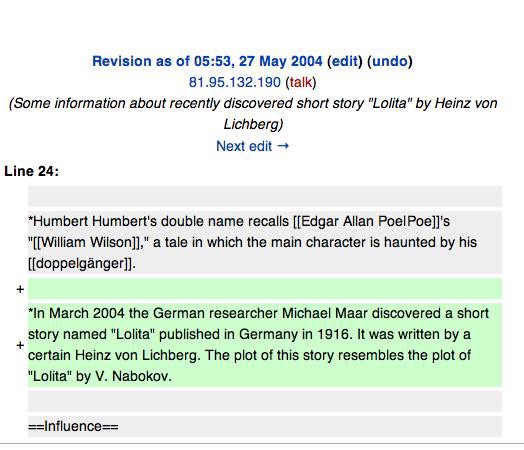
After Maar’s book came out in October 2005, the idea of “cryptomnesia,” that is, “when a forgotten memory returns without it being recognized as such by the subject, who believes it is something new and original,” was added as a possible reason for the similarities between Nabokov’s and von Lichberg’s respective “Lolitas.”
Jonathan Lethem’s February 2007 Harper’s article called “The Ecstasy of Influence: A Plagiarism” briefly mentions Maar’s discovery, which may account for the Lolita page’s highest number of views in January of the same year.
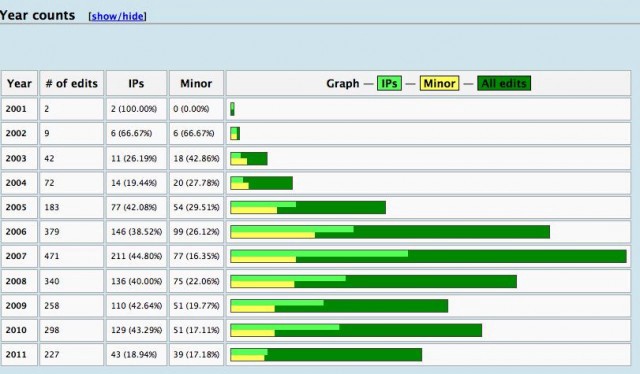
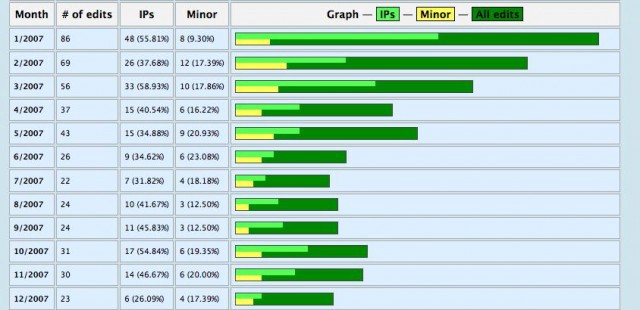
DEBATE
Here’s where the arguments start, and where the tenet of neutrality gets challenged. Over the years, editors have disagreed over what terms to use to describe Humbert Humbert, Lolita and the relationship between them. After all, how do you transform sentences such as this into neutral prose?: “There my beauty lay down on her stomach, showing me, showing the thousand eyes wide open in my eyed blood, her slightly raised shoulder blades, and the bloom along the incurvation of her spine, and the swellings of her tense narrow nates, clothed in black, and the seaside of her schoolgirl thighs.”
On calling Humbert Humbert a “pedophile”:


On “pedophile” vs. “(h)ephebophile,” and distinguishing the two. These edits went back and forth over the course of December 14–17, 2009:
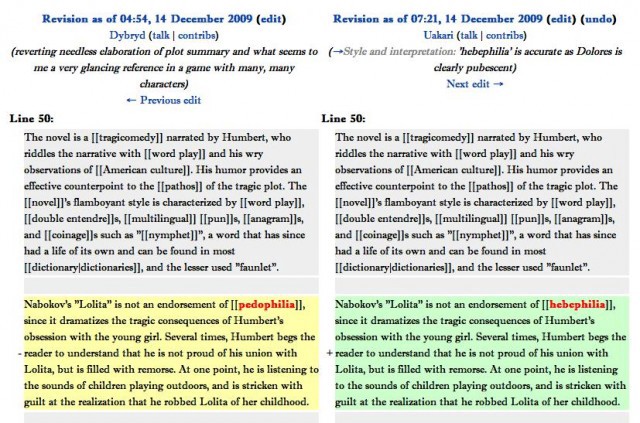
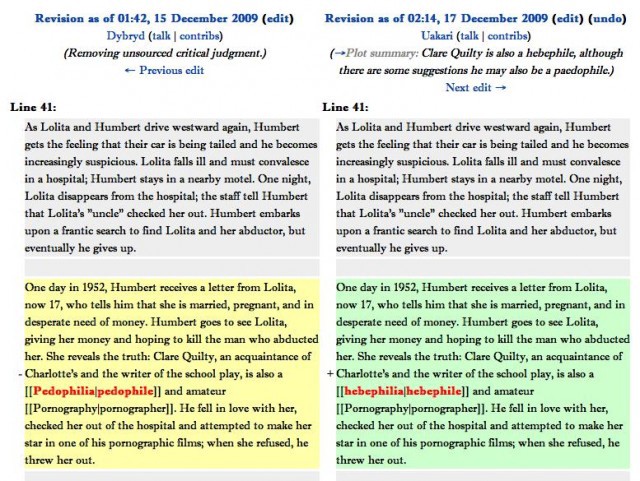
On whether to judge him for it:


On whether the nature of their relationship makes Humbert Humbert a reliable narrator or not:
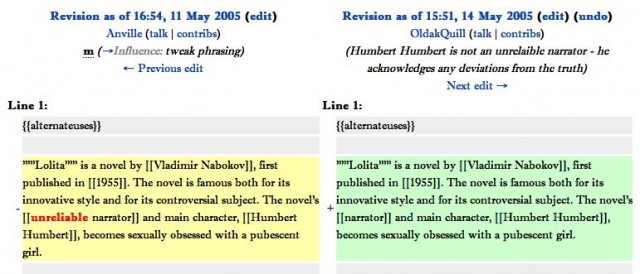
One of the most consistent debates is over the use of “pre-pubescent” versus “pubescent” in describing Lolita’s age.

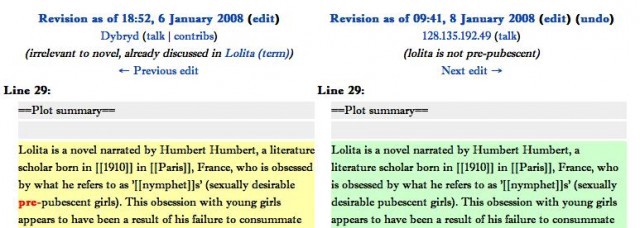
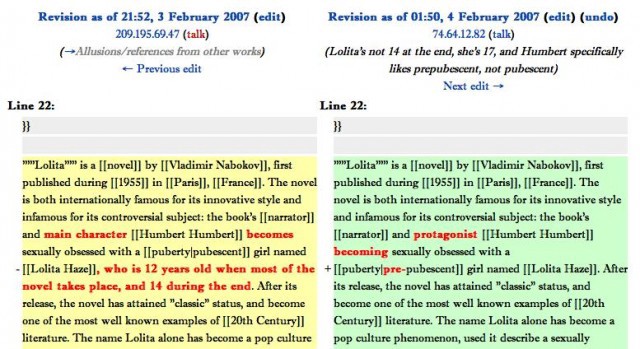
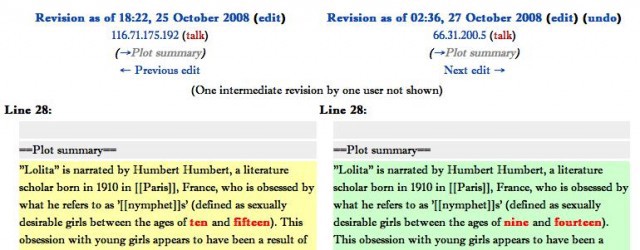
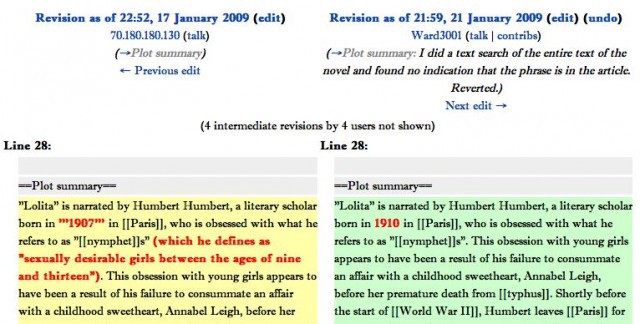
Note: Merriam-Webster defines puberty as “the condition of being or the period of becoming first capable of reproducing sexually marked by maturing of the genital organs, development of secondary sex characteristics, and in the human and in higher primates by the first occurrence of menstruation in the female.” Or, as Humbert Humbert himself reports: “The median age of pubescence for girls has been found to be thirteen years and nine months in New York and Chicago. The age varies for individuals from ten, or earlier, to seventeen.”
This isn’t Humbert’s first circling of the topic. Earlier in the novel he says:
Between the age limits of nine and fourteen there occur maidens who… I propose to designate as “nymphets. It will be marked that I substitute time terms for spatial ones. In fact, I would have the reader see “nine” and “fourteen” as the boundaries — the mirrory beaches and rosy rocks — of an enchanted island haunted by those nymphets of mine and surrounded by a vast, misty sea.
Dude’s a pedophile. A poetic one.
On Lolita’s name, and whether to call her a “heroine” or not.


The constant back-and-forth over word choice is just a microcosm of the same (albeit slightly less charged) issue of relaying the plot. This revision from January 2007 changes “rhapsodize over Lolita in her sleep” to “sexually molest Lolita without fear of discovery.”

Entries such as the one on Lolita demonstrate why perfection on Wikipedia remains an “unattainable” goal — when the topic is contentious, perfection will always butt heads against “is completely neutral and unbiased.” One man’s undeniable literary masterpiece is another man’s abominable pedophilic trash, and they’re both editors on Wikipedia. The edits to the Lolita page (and any Wikipedia page) can seem tedious and petty, and many of them are. But the users’ vigilance in keeping some words and changing others, and debating over content and style, does have a purpose: it keeps critical thinking alive and well. The writing, editing, rewriting and re-editing process of a Wikipedia page creates a new entity — the Lolita Wikipedia page, which is not Nabokov’s Lolita, but a work in its own right. In the collaborative editing process, any reader can use the Lolita page to challenge its meaning. In fact, he can reach right in and edit it himself, until someone else edits it again.
Emily Morris is a summer Awl reporter.
